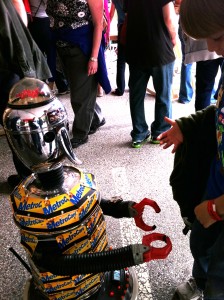Interaction Relabeling and Extreme Characters:
Methods for Exploring Aesthetic Interactions
J.P. Djajadiningrat, W.W. Gaver, and J.W. Frens
This article discusses how interaction considers appearance, actions, and role. The notion of ease of use, efficiency, and “productivity over exploration and curiosity” is emphasized in the reading. Interaction design works towards being aesthetically powerful. For example, a Swiss Army knife, is more like a gadget product because it is precise and complex, according to Djajadiningrat, Gaver, and Frens. The reading also addresses the dangers of designing for “prototypical characters”; When this is done then we are ignoring the entire spectrum of human emotions because it only considering socially or culturally desirable things. When we design for characters that have embellished emotional attitudes than that is something to consider in the process. We have to keep in mind the importance of the choice of character. Designing for extreme characters exposes some emotions and characteristics which are hidden in certain cases.
Hertzian Tales
Anthony Dunne
Hertzian Tales addresses how designers should consider to think broadly about aesthetics and specifically the role of electronic products in daily life. Industrial design potentially can enrich our daily lives and create social benefits. For example, AT&T has a patent for metal coating that changes color when a low voltage is sent through it. AT&T wants to use this novel technology to enable phones to change color instead of ringing. Hertzian Tales mentions how connecting different pieces and information results in interactive surfaces that are exciting.
The Design of Everyday Things
Donald Norman
The user should not need a picture or instruction set to understand a design. If they do the design has failed. The reading talks about specialized objects like food utensils, scissors, clips, and various objects that people are expected to know how to use because of their knowledge about how things work everyday. Normans suggests that a good conceptual model allows us to determine the effect of our actions. He also talks about how poor design causes unnecessary problems for the end user. He gives the example of a door and if it has to come with a one-word instruction manual than it is poorly designed and has ultimately failed. The push and pull bar on doors that is required by law in the US forces proper behavior when people are caught in dangerous situations and unable to think clearly in a fire. Norman also writes about the car radio and how the designers need to consider gloves, high speed, and touch tremendously to create something smart for the driver. He goes on further to address visibility and feedback. Sounds help determine if things are working properly or if an item needs to be fixed. It can prevent accidents, yet we also have to be careful it does not annoy people and be a major distraction.
The Computer Revolution Hasn’t Happened Yet
Alan Kay
I found the term “infonaut” to be the most fascinated part of this article. An infonaut is a person who navigates the information superhighway. (Also known as an avid internet user.) Kay recognizes the patriarchs, pioneers, and infonauts, and hackers that have formed the computer revolution over generations. Today technology is changing so fast that is is nearly impossible for people to keep up with the latest and greatest.
Why We Need Things
Mihaly Csikszcntmihalyi
Csikszcntmihalyi presents us with a statistic that every American will own more than 400 hundred electronic appliances during his/her lifetime. Today I sat in a lecture by his son Chris who’s student worked on appliances for females. For example, the student created a blender that when the female yelled it started working, but only upon certain tones. It was quite fascinating and funny. You can check it out in further detail here: http://eyebeam.org/people/kelly-dobson
Mihaly explains that when people have nothing to do, the generally begin to become depressed and their moods overtime deteriorate. In general people that have objects with meaning in their homes that evoke friendship, family, and relationships feel less socially isolated. Objects increase our sense of security and reinforce a person’s opinion about themselves.
What do Prototypes Prototype?
Stephanie Houde and Charles Hill
Houde and Hill introduced the notion of prototype as a communication vehicle. They explained that prototypes represent changing states of designs overtime. They stressed the importance to explore possibilities and not settle on the first option. They also addressed how when thinking and communicating about design there are issues of teamwork. Audiences are vital to consider and engage with when prototyping. Some projects require teams built of a programmer, an interaction designer, an industrial designer, and a project manager. It is important as designer that we keep in mind a specific audience and potential users and test whatever we are creating on them in order to verify the products use before going into production. Throughout the prototyping creative process we can then balance and resolve constraints because ultimately the design should be coherent as Houde and Hill explain. The writers bring up the idea of low and high fidelity. Low-fidelity prototypes might be built to solve certain issues and to show a proof of concept new technology. Some important questions are asked in the article, including: “What role will it play in a users life? How should it look and feel? How should it be implemented?” Overall what I took out of the reading is that as a designer I need to build multiple prototypes. “Know my audience” and prepare my audience by clearly presenting the new prototype as what it is and is not.

















